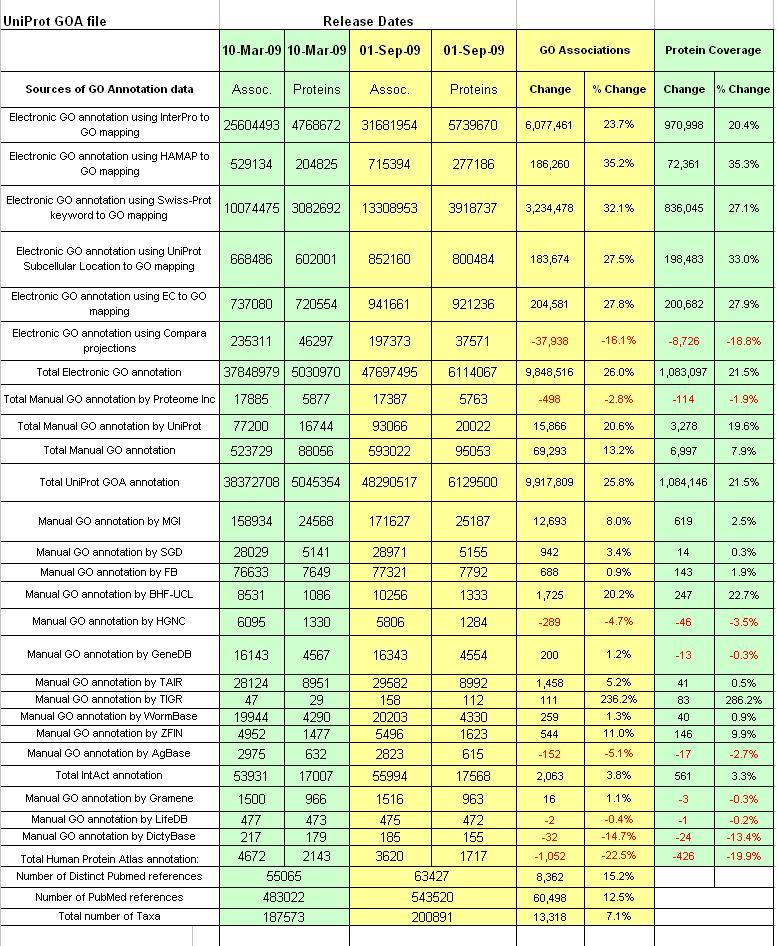GOA, September 2009: Difference between revisions
m (→Staff:) |
|||
| Line 19: | Line 19: | ||
Tony Sawford | Tony Sawford | ||
Swiss-Prot contributors (EBI, Hinxton, UK and SIB, Geneva, Switzerland) | |||
Ioannis Xenarios | |||
Amos Bairoch | |||
Lydie Bougueleret | |||
Serenella Ferro-Rojas | |||
Andrea Auchinchloss | |||
Marie-Claude Blatter | |||
Emmanuel Boutet | |||
Lionel Breuza | |||
Alan Bridge | |||
Paul Browne | |||
Wei Mun Chan | |||
Elizabeth Coudert | |||
Louise Daugherty | |||
Ruth Eberhardt | |||
Anne Estreicher | |||
Livia Famiglietti | |||
Marc Feuermann | |||
Rebecca Foulger | |||
Nadine Gruaz-Gumowski | |||
Ursula Hinz | |||
Silvia Jimenez | |||
Florence Jungo | |||
Guillaume Keller | |||
Kati Laiho | |||
Duncan Legge | |||
Philippe Lemercier | |||
Damien Lieberherr | |||
Michele Magrane | |||
Ivo Pedruzzi | |||
Sylvain PouxCatherine Rivoire | |||
Bernd Roechert | |||
Michel Schneider | |||
Eleanor Stanley | |||
Andre Stutz | |||
Shyamala Sundaram | |||
Michael Tognolli | |||
= Annotation Progress = | = Annotation Progress = | ||
Revision as of 11:00, 16 September 2009
Gene Ontology Annotation at UniProtKB, 2009
Report on the GOA team's activities between March 2009 and September 2009.
Staff:
Rolf Apweiler
Claire O'Donovan
Emily Dimmer
Rachael Huntley
Yasmin Alam-Faruque
Daniel Barrell
David Binns
Tony Sawford
Swiss-Prot contributors (EBI, Hinxton, UK and SIB, Geneva, Switzerland)
Ioannis Xenarios Amos Bairoch Lydie Bougueleret Serenella Ferro-Rojas
Andrea Auchinchloss Marie-Claude Blatter Emmanuel Boutet Lionel Breuza Alan Bridge Paul Browne Wei Mun Chan Elizabeth Coudert Louise Daugherty Ruth Eberhardt Anne Estreicher Livia Famiglietti Marc Feuermann Rebecca Foulger Nadine Gruaz-Gumowski Ursula Hinz Silvia Jimenez Florence Jungo Guillaume Keller Kati Laiho Duncan Legge Philippe Lemercier Damien Lieberherr Michele Magrane Ivo Pedruzzi Sylvain PouxCatherine Rivoire Bernd Roechert Michel Schneider Eleanor Stanley Andre Stutz Shyamala Sundaram Michael Tognolli
Annotation Progress
We continue to put emphasis on the annotation of those genes selected for the Reference Genome Project.
In addition, with the newly started kidney-centric annotation project, additional emphasis has been placed on certain genes associated with renal development and disease.
Methods and strategies for annotation
- Literature curation:
Literature curation continues to be the major focus of our annotation efforts, with an emphasis on the use of experimental evidence codes.
- Computational annotation strategies:
GOA provides IEA annotations from the following methods:
- Swiss-Prot Keyword 2GO (SPKW2GO)1,2
- Swiss-Prot Subcellular Locations2GO (SPSL2GO) 1,2
- HAMAP2GO2
- InterPro2GO2
- EC2GO2
- Ensembl Compara
Legend
1: mapping tables created and maintained by the GOA group
2: electronic annotations generated by the GOA group, using UniProtKB.
- Priorities for annotation
- Genes assigned by Reference Genome Project (Rachael, Emily)
- Genes associated with renal processes (Yasmin)
- Requests from user community (all curators)
- Proteins annotated during Swiss-Prot curation duties (all Swiss-Prot curators at the EBI and SIB)
Presentations and Publications
a. Papers with substantial GO content
Atherosclerosis. 2009 Jul;205(1):9-14. Improvements to cardiovascular gene ontology. Lovering RC, Dimmer EC, Talmud PJ.
PLoS Comput Biol. 2009 Jul;5(7):e1000431. The Gene Ontology's Reference Genome Project: a unified framework for functional annotation across species. Reference Genome Group of the Gene Ontology Consortium.
b. Presentations including Talks and Tutorials and Teaching
June 2009 - Presentation of GOA and the Renal Annotation Initiative at Edinburgh University (GUDMAP Consortium), Yasmin Alam-Faruque
7-8th September 2009 - Renal Gene Ontology Annotation Initiative Poster and presentation for the Kidney Research Fellows Day, Yasmin Alam-Faruque
23rd April, 1st July, 2nd SeptemberGO annotation training of Swiss-Prot curators at the Swiss Institute of Bioinformatics, Geneva, Switzerland, Emily Dimmer and Rachael Huntley
17-18th September British Atherosclerosis Society Autumn Meeting; 'Genetics of Complex Diseases'. Introduction to GO. Emily Dimmer and Ruth Lovering.
Other Highlights
New staff:
Yasmin Alam-Faruque
Tony Sawford
A. Ontology Development Contributions:
x GO terms have been created during annotation efforts by the group
B. Annotation Outreach and User Advocacy Efforts:
GOA is currently training curators at the Swiss Institute of Bioinformatics. Rachael and Emily have been travelling to Geneva on the to train Swiss-Prot curators. Rachael and Emily then checked all annotations generated by this group over the following 2 months before making the annotations public. The Swiss-Prot team in Geneva have so far generated approximately x,000 manual GO annotations. Annotations are created in GOA's protein2go tool, and released in the groups gene association files. Such annotations use the existing source 'UniProtKB' (for column 15 of the gene association file).
GOA will continue to train and mentor SIB curators over 2009 and 2010.
C. Other
Renal GO annotation initiative funded by Kidney Research UK.
This grant started on the 1st April, managed by Yasmin Alam-Faruque, who joined GOA from the Swiss-Prot team at the EBI.
PROGRESS REPORT
Gene Association File changes July 2009 Previously, annotation lines produced by electronic methods (as indicated by the presence of the 'IEA' evidence code in column 7) contained two identifiers piped together in the reference column; an internal GOA keyword (e.g. GOA:interpro) and a GO reference identifier (e.g. GO_REF:0000002). As of this fille release, the GOA internal reference (e.g. GOA:interpro) and pipe has been removed from this field, so that only a GO_REF identifier is provided.
May 2009 DB field (column 1). Column 1 of the gene association file is used to identify the database which has supplied the sequence identifier displayed in column 2. Its value is very often 'UniProtKB'. However recent changes to other fields in the GOA gene association files have made it difficult for users to identify whether an UniProtKB accession originates from the UniProtKB/Swiss-Prot or UniProtKB/TrEMBL databases. Therefore it is intended that when a UniProtKB accession is provided in column 2, column 1 will in future display either 'UniProtKB/Swiss-Prot' or 'UniProtKB/TrEMBL'.
